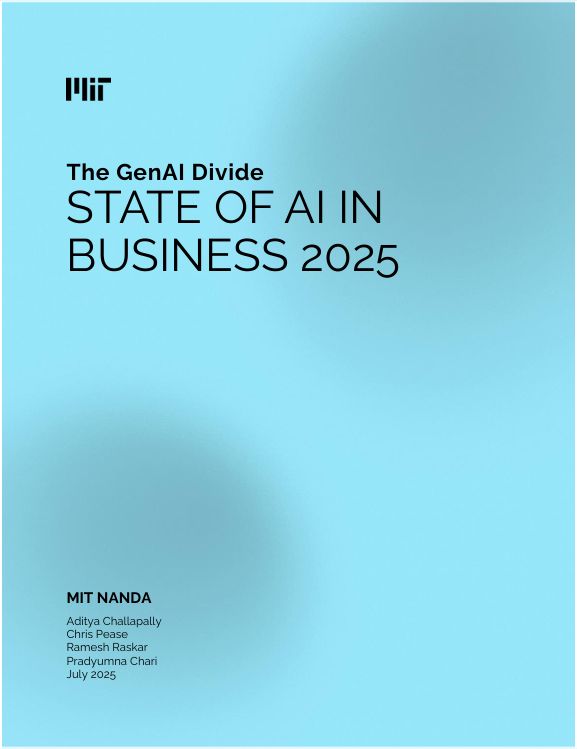Generative AI (GenAI) has quickly become the buzzword in boardrooms, strategy meetings, and conference stages. Yet behind the hype, a stark truth emerges: while organizations are pouring billions into AI, only a handful are seeing real business transformation.
The recently released *State of AI in Business 2025 Report* sheds light on what's working, what's failing, and where the future is headed. I've distilled 10 key insights from the report that every leader, innovator, and decision-maker should understand.
1. The GenAI Divide is widening
Companies have invested $30–40 billion into GenAI initiatives, but a staggering 95% report no measurable ROI. Only 5% of projects are crossing the "GenAI Divide" to deliver tangible P&L impact.
The winners aren't spending more—they're approaching AI differently.
2. Adoption is high, transformation is rare
More than 80% of organizations use tools like ChatGPT or Copilot. But these tools improve productivity for individuals, not bottom-line results for companies. In fact, only Tech and Media show meaningful structural change, while other sectors lag behind.
Hype ≠ transformation.
3. Pilots stall before production
Custom enterprise AI solutions rarely make it past the pilot stage. Only 5% of pilots scale into production, blocked by poor integration, brittle workflows, and lack of contextual learning.
Without systems that learn and adapt, pilots stay stuck in "demo mode."
4. Employees are already ahead—welcome to the Shadow AI economy
While official deployments crawl, employees are charging ahead with personal AI accounts. Over 90% of workers use ChatGPT or Claude privately to automate tasks, compared to only 40% of companies with official LLM subscriptions.
The workforce is crossing the divide on its own. Enterprises that ignore this trend risk falling behind their own employees.
5. Budgets flow where visibility is high—not where ROI is real
Half of all AI budgets are directed at sales and marketing—personalized content, outbound emails, lead scoring. These are easy to measure, easy to justify. Yet, the highest ROI often comes from back-office automation in finance, procurement, and operations.
The "sexy" use cases get the dollars. The overlooked ones deliver the returns.
6. The missing link: systems that learn
Why do consumer tools win? ChatGPT feels useful for quick drafting, brainstorming, and summaries. But in mission-critical workflows, it fails because it forgets context, doesn't adapt, and can't evolve.
Intelligence isn't enough—memory and adaptability are what make AI enterprise-ready.
7. Agentic AI shows the way forward
The leaders are moving toward agentic AI systems—tools that embed memory, learn from feedback, and integrate deeply into workflows. Early adopters report multi-million-dollar deployments within months.
Agentic systems transform AI from a "chatbox" into a true workflow partner.
8. External partnerships double success rates
Internal builds fail more often than they succeed. Research shows that external partnerships are twice as likely to deliver scalable AI outcomes.
Trust, customization, and co-development beat going it alone.
9. Real ROI is hiding in the back office
The most successful companies are saving $2–10M annually by cutting BPO spend, reducing agency fees, and automating repetitive support tasks. These aren't flashy headlines, but they free up budgets and improve resilience.
Quiet efficiency often outperforms loud innovation.
10. The next wave: the Agentic Web
Beyond individual AI agents lies the Agentic Web—a network of autonomous, interoperable agents that can transact, negotiate, and self-optimize across the internet. Imagine procurement systems that discover suppliers, negotiate terms, and execute contracts without human input.
The shift from SaaS apps to self-coordinating AI agents could reshape entire industries.
Final Thoughts: Crossing the Divide
The *State of AI in Business 2025* makes one thing clear: success isn't about throwing money at the newest model. It's about choosing systems that learn, remember, and adapt.
Organizations crossing the divide do three things differently:
- Buy, not build: Partner with vendors who deeply understand workflows
- Empower front-line managers: Enable prosumer employees to drive adoption
- Measure ROI in operations: Focus on real business impact, not shiny demos
The GenAI Divide is real—but it's not permanent. The next 18 months will decide who stays stuck in pilots and who scales into the post-pilot AI economy.
Additional Resources
Download the full State of AI in Business 2025 Report - Access the complete research findings, methodology, and detailed analysis behind these insights.
Connect with Us
See this post on our LinkedIn - Check out our latest insights on bridging the GenAI divide and AI business transformation strategies.
Follow us for more insights on AI automation, business transformation, and enterprise AI implementation strategies!
Over to you: Is your organization still experimenting with GenAI—or have you crossed the divide into real business impact?
